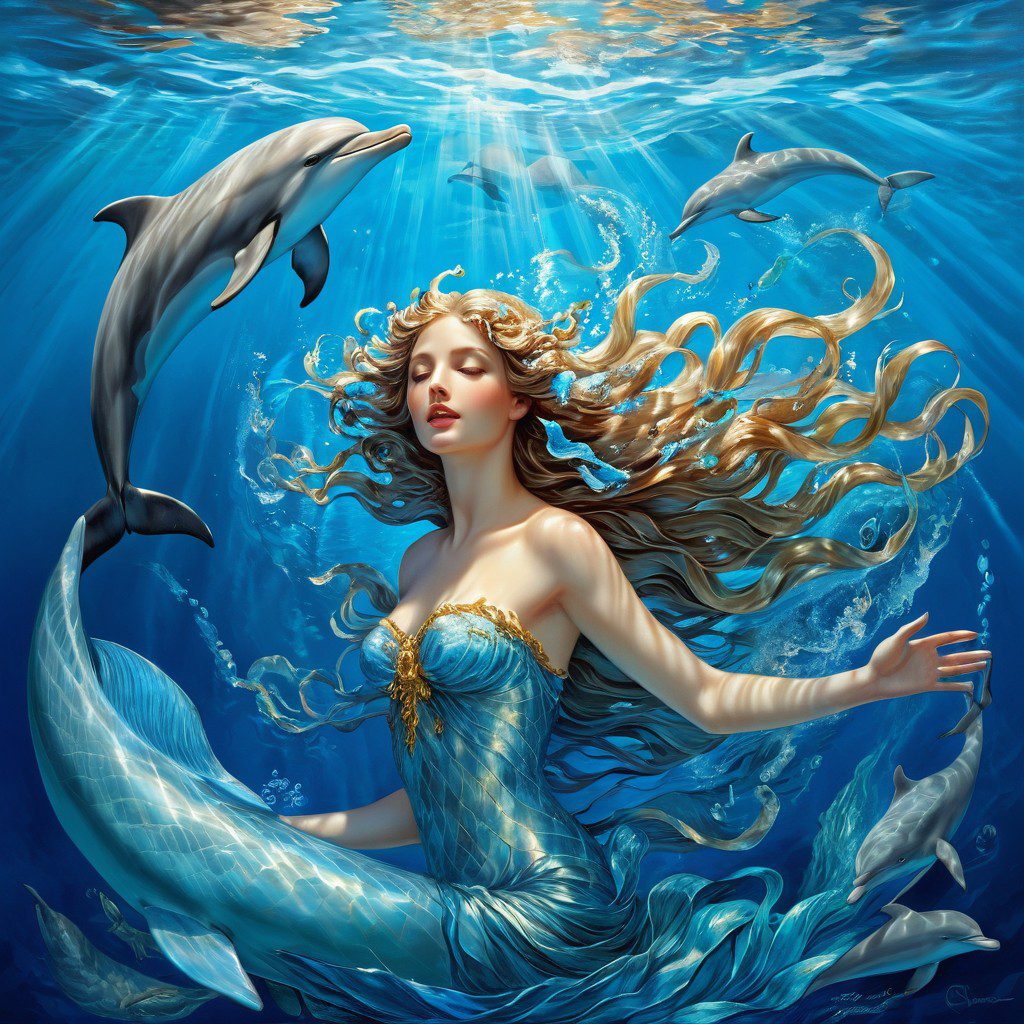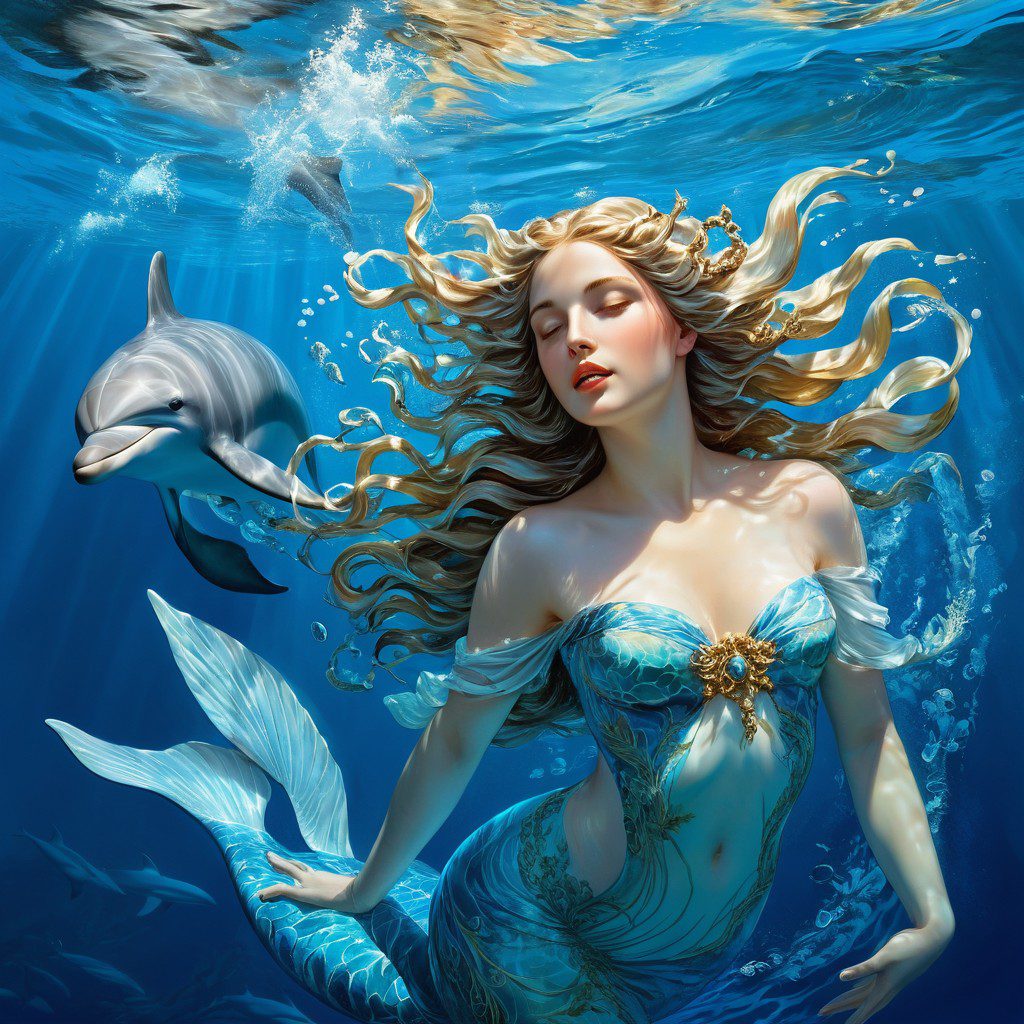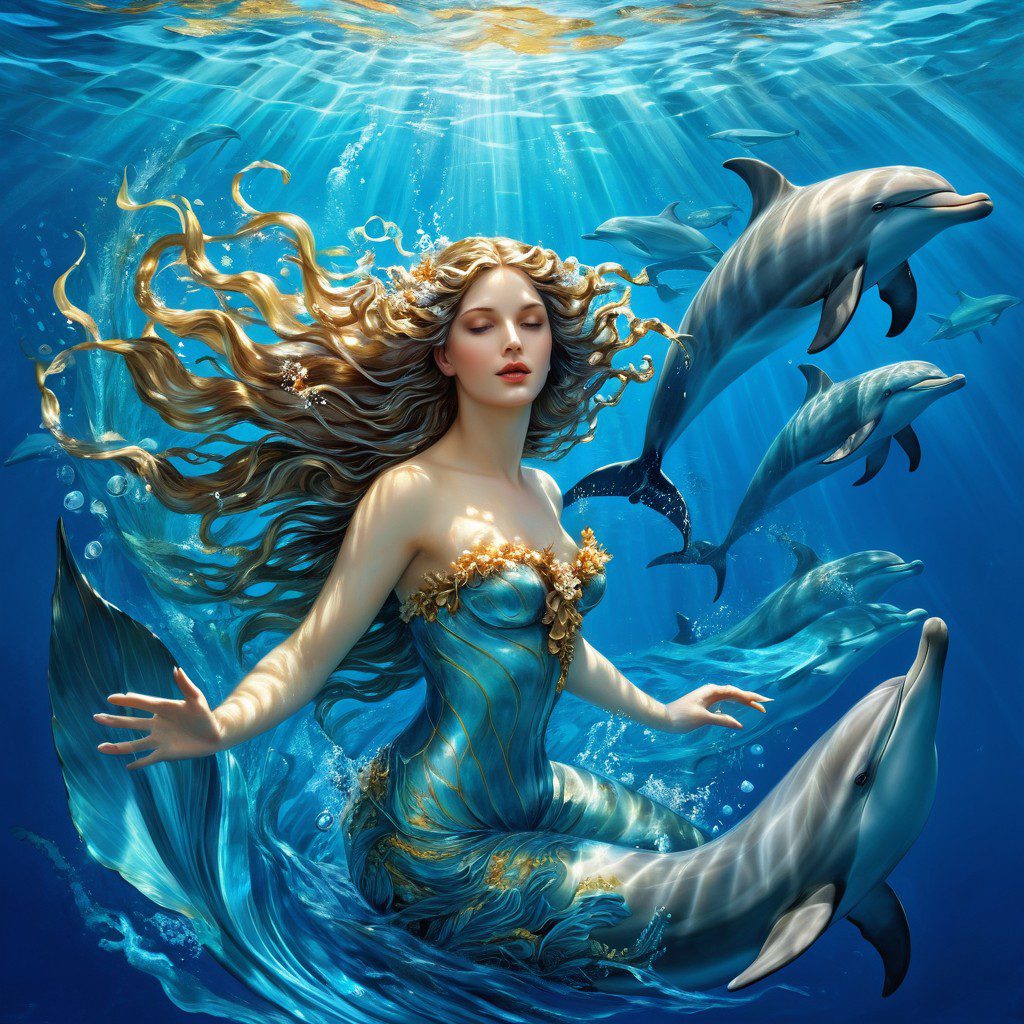The Nereids: Sea Nymphs of Greek Mythology

The Nereids, known as the graceful and benevolent sea nymphs of Greek mythology, are daughters of the sea god Nereus and the ocean goddess Doris. These 50 sisters personify the beauty, calmness, and bounty of the ocean, and are often associated with its gentler aspects. Unlike other dangerous sea creatures in Greek myth, such as Scylla or Charybdis, the Nereids are depicted as protectors of sailors and heroes, offering their guidance and aid to those in need.
Their mythological roles, as well as their connection to specific gods and heroes, have secured the Nereids’ lasting place in ancient literature and art. From Homer’s Iliad to modern media, the Nereids represent the nurturing and mysterious qualities of the sea, balancing the chaotic forces with their serene presence.
50 Nereids, the sisters.
- Amphitrite – Queen of the sea, wife of Poseidon, ruling over the vast ocean depths.
- Thetis – Known for prophecy, transformation, and as mother of Achilles; I am a protector of those who respect the sea.
- Galatea – Represents the gentle beauty of the sea, known for her love for the mortal Acis.
- Psamathe – Guardian of sandy shores and protector of the coastline, also connected to mortal lineage through her marriage to Aeacus.
- Cymodoce – Presides over the waves, ensuring their steady rise and fall.
- Panopea (Panope) – Protects sailors, calming waters to aid safe passage.
- Doto – Brings bounty to the sea, often associated with the abundance of fish.
- Nesaia – Personifies the calm, deep sea, maintaining its tranquility.
- Speio – A guardian of sea caves and rocky coastal waters.
- Thalia – Associated with the flowering of sea life and natural beauty.
- Nereis – Embodies the pure, unpolluted essence of the ocean.
- Eulimene – Protector of harbors and coves.
- Eunice – Known for swift waters and the movement of currents.
- Glauce – Connected to the glimmer and translucence of shallow waters.
- Cymothoe – Calms the waves during storms, aiding those caught in rough seas.
- Actaea – Watches over the rocky coastlines and cliffs.
- Dexamene – Symbolizes the resilience of ocean life in harsh conditions.
- Kymatolege – Holds sway over powerful surges and large waves.
- Ianeira – Associated with clear, still waters.
- Apseudes – Keeps the deep ocean free from disturbances.
- Eione – Known for nurturing sea creatures along the shores.
- Protomedeia – A guide for sailors, offering wisdom in navigation.
- Amatheia – Healer of marine creatures and protector of fish.
- Eucrante – Brings favorable winds and currents.
- Agave – Represents the sea’s wild, untamed beauty.
- Eudora – Bestows the ocean’s blessings upon fishermen.
- Themistonoe – Known for harmony and order within the ocean’s depths.
- Lysianassa – Brings peace to turbulent waters.
- Eukrante – Ensures safe arrivals at ports and shores.
- Autonoe – Associated with the hidden depths of the sea, protecting secret places.
- Neomeris – Linked to the sparkling foam of the sea.
- Halie – Protector of marine life and biodiversity.
- Melite – Represents the gentler aspects of the sea, often soothing distressed waters.
- Dione – Known for her radiant beauty, embodying the allure of the sea.
- Ceto – Oversees marine creatures, especially those in the dark depths.
- Pherusa – Associated with the power of ocean currents.
- Dero – Represents the ebb and flow of tides.
- Galene – Presides over calm seas and gentle breezes.
- Pontomedusa – Connected to the mysteries of the deep ocean.
- Hippothoe – Embodies the swiftness of the sea’s currents.
- Hipponoe – Known for the peacefulness of the sea’s surface.
- Cymodice – Associated with safe harbors and shelter for ships.
- Ephyra – Presides over brackish waters where rivers meet the sea.
- Ophelia – Protector of young sea life.
- Deianeira – Represents the ocean’s strength and endurance.
- Laomedeia – Associated with underwater meadows and plant life.
- Maera – Guardian of underwater caverns and grottoes.
- Orithyia – Associated with strong ocean winds and waves.
- Panopaea – Protects those at sea, ensuring safe journeys.
- Nautaea – Guardian of distant waters and vast open seas.
Origins and Mythological Background
The Nereids are named after their father, Nereus, often called the “Old Man of the Sea.” Nereus, unlike the other more wrathful sea deities, was known for his wisdom, kindness, and prophetic abilities. He and Doris, a daughter of the Titan Oceanus, produced the Nereids, making them part of a divine lineage connected to both the Titans and the primordial forces of the ocean.
The Nereids are typically portrayed as beautiful maidens, with long flowing hair, often draped in seaweed or coral, symbolizing their connection to the sea. They dwell in the depths of the Mediterranean, particularly near islands and along the seashores. Their primary role is to represent the nurturing aspects of the ocean and to act as intermediaries between gods and mortals, often helping sailors navigate treacherous waters or assisting heroes in their quests.
Nereids in Greek Mythology
The Nereids appear in many important Greek myths, frequently offering assistance to gods and mortals alike. While the group as a whole represents the benevolent side of the sea, several individual Nereids stand out for their significant roles in mythology.
The Famous Nereids:


- Thetis – Perhaps the most famous of all the Nereids, Thetis is the mother of the Greek hero Achilles. She plays a significant role in both the Iliad and various myths surrounding Achilles’ life. After marrying the mortal king Peleus, Thetis attempted to make Achilles immortal by dipping him in the River Styx. However, she left his heel vulnerable, leading to the famous story of the “Achilles heel.” In Homer’s Iliad, Thetis aids Achilles during his trials in the Trojan War, even pleading with Zeus on his behalf. Her actions reveal both the Nereids’ protective nature and their ability to influence the gods.
- Amphitrite – Another important Nereid, Amphitrite is the wife of Poseidon, the god of the sea, and is often depicted as the queen of the ocean. Though her role in myth is somewhat more subdued, Amphitrite represents the stable and nurturing aspects of the sea, in contrast to Poseidon’s tempestuous nature. She is the mother of Triton, the merman who serves as Poseidon’s herald.
- Galatea – Known from the myth of Acis and Galatea, this Nereid features in a tragic love story. She fell in love with the mortal Acis, but their romance was disrupted by the cyclops Polyphemus, who killed Acis in a fit of jealousy. This myth highlights the Nereids’ ability to love mortals, as well as their vulnerability to the dangers of the mortal world.
- Psamathe – Another Nereid who became involved with mortals, Psamathe married the mortal king Aeacus and bore a son, Phocus. Her story is tied to the complex relations between gods and mortals, emphasizing the Nereids’ connections to both worlds.
Symbolism of the Nereids
The Nereids represent the sea in its most benevolent form. They are a stark contrast to other mythological sea creatures that embody the ocean’s destructive side. While gods like Poseidon could whip up storms or create earthquakes, the Nereids offer a sense of balance, guiding mortals through the perils of the sea and aiding them in times of need.
Protection and Guidance: The Nereids’ most prominent symbolic role is as protectors. Sailors in ancient Greece would often pray to them for safe passage, hoping to win their favor. In this sense, the Nereids symbolize hope, safety, and the idea that even in the dangerous depths of the ocean, there is guidance and mercy.
Beauty and Nurturing: The Nereids’ connection to the ocean also links them to fertility and abundance. The sea, as a provider of food and life, was central to the Greek understanding of the natural world, and the Nereids’ association with calm waters and safe harbors represents the nurturing qualities of the natural world.
Intermediaries Between Worlds: Like many other divine figures in Greek mythology, the Nereids often serve as intermediaries between gods and mortals. They help bridge the gap between the two realms, providing aid to humans while remaining tied to the divine forces of the ocean. This reflects a broader theme in Greek mythology, where certain deities have the power to influence both worlds.
The Nereids in Ancient Art and Literature
The Nereids are frequent subjects of ancient Greek art, often depicted in sculptures, frescoes, and pottery. In many cases, they are shown riding dolphins, symbolizing their command over sea creatures and their harmonious connection to marine life. In ancient vase paintings, they appear alongside gods like Poseidon or escorting ships, further emphasizing their role as protectors of sailors.
In literature, the Nereids are prominent in Homer’s Iliad and Ovid’s Metamorphoses, two of the most significant works of the classical world. Their role as protectors and figures of divine assistance is reinforced through these texts, where they often serve as benefactors to the heroes or as participants in divine councils.
In the Iliad, Thetis’s plea to Zeus to honor Achilles reflects the influence of the Nereids in matters of both mortal and divine concern. Her ability to directly converse with the king of the gods suggests that, while the Nereids are not Olympian gods, they still wield significant influence. Similarly, in Ovid’s Metamorphoses, the story of Galatea and Acis provides a tragic, yet humanizing, portrayal of the Nereids, showing them capable of deep emotion and love for mortals.
The Nereids in Modern Media
While not as prominent in modern media as other mythological figures, the Nereids still make appearances in literature, films, and video games. Often portrayed as graceful, benevolent figures, they continue to symbolize the peaceful aspects of the ocean and the mysteries of the sea.
- Literature: In modern fantasy novels and myth-inspired works, the Nereids are occasionally depicted as sea nymphs or guardians of the ocean, though their roles are often combined with other aquatic deities. In Rick Riordan’s Percy Jackson series, Thetis plays a brief role, reflecting her importance as the mother of Achilles and her influence over divine and mortal affairs.
- Video Games: In the world of video games, sea nymphs and ocean deities often take inspiration from the Nereids. Games such as Assassin’s Creed Odyssey, which explore Greek mythology, feature Nereid-like figures as part of the mythological landscape, offering players a glimpse of their serene power.
- Film and TV: While Nereids are not frequently depicted in films or TV shows, they often inspire characters in media that draw from Greek myth. The presence of beautiful, helpful sea creatures is a recurring motif in adaptations of mythological stories, echoing the Nereids’ legacy as protectors of the ocean.
Strengths and Weaknesses of the Nereids
Strengths:
- Protection and Guidance: The Nereids are benevolent protectors, particularly of sailors and heroes. Their knowledge of the ocean and its dangers allows them to guide those in need to safety, offering calm seas and safe passage.
- Divine Influence: As daughters of Nereus and connected to the Olympian gods, the Nereids wield significant influence, both in their ability to assist mortals and in their ties to the gods of the sea, particularly Poseidon and Zeus.
- Beauty and Harmony: Representing the harmonious and nurturing aspects of the sea, the Nereids embody grace, beauty, and balance. They are seen as the gentler, more compassionate side of the ocean’s power.
Weaknesses:
- Limited to the Sea: The Nereids’ power is tied to the sea and the ocean’s borders. They are less influential on land or in realms outside their natural habitat, which limits their scope of power.
- Vulnerability to Love and Emotion: Like many nymphs, the Nereids are often susceptible to the emotions and passions of mortals. Their love for human beings, as seen in stories like Galatea’s, can lead to heartbreak or tragedy, making them vulnerable to the human world’s harsh realities.
- Subordinate to Higher Gods: While the Nereids are influential, they are still subject to the will of the Olympian gods, especially Poseidon. This subordination means they cannot always act independently and must often obey the commands of more powerful deities.
The Legacy of the Nereids
The Nereids continue to represent the serene and nurturing aspects of the sea, providing a counterbalance to the chaotic and destructive forces often depicted in oceanic myths. Through figures like Thetis, Amphitrite, and Galatea, they have maintained a presence in art, literature, and modern media as symbols of guidance, beauty, and the deep, mysterious power of the sea.
Their stories reflect the intricate relationship between mortals and the divine in Greek mythology, offering lessons on love, protection, and the balance between life’s calm and stormy waters.
